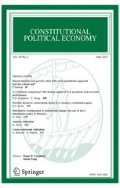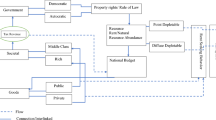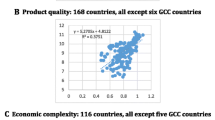Abstract
While many consider institutional quality as a central explanatory variable when finding what causes the variance in per capita GDP growth performance of resource-abundant countries, this paper attempts to focus on more structural factors: regime type and its ideological approaches to economic policy. Several joint effects of natural resource abundance and regime type on growth are found. The natural resource curse is likely to be more severe in authoritarian regimes than democratic regimes. Among democracies, it is found that the natural resource curse is more salient in presidential regimes than in parliamentary regimes. This paper also suggests that the natural resource curse is more likely when a certain type of democratic regime coincides with a particular ideological orientation of the regime with respect to economic policy. Presidential democracies with left-wing economic policy are found to be least growth enhancing among the combinations between regime type and its economic ideology offered, given similar levels of natural resource abundance.



Similar content being viewed by others
References
Andersen, J., & Aslaksen, S. (2007). Constitutions and the resource curse. Journal of Development Economics, 87(2), 227–246.
Auty, R. (2001). Resource abundance and economic development. Oxford: Oxford University Press.
Barro, R. (1991). Economic growth in a cross section of countries. Quarterly Journal of Economics, 106(2), 407–443.
Barro, R. (1996). Democracy and growth. Journal of Economic Growth, 1(1), 1–27.
Barro, R., & Sala-i-Martin, X. (1992). Convergence. Journal of Political Economy, 100(2), 223–251.
Bjornskov, C. (2005). Does political ideology affect economic growth? Public Choice, 123(1), 133–146.
Boschini, A., Pettersson, J., & Roine, J. (2007). Resource curse or not: A question of appropriability. Scandinavian Journal of Economics, 109(3), 593–617.
Boschini, A., Pettersson, J., & Roine, J. (2008). The constitutional channels of the resource curse. Thematic Session, No. 8.
Bueno de Mesquita, B., Smith, A., Siverson, R., & Morrow, J. (2003). The logic of political survival. Cambridge: The MIT Press.
Cruz, C., Keefer, P., & Scartascini, C. (2016). Database of political institutions codebook 2015 update.
Easterly, W. (2011). Benevolent autocrats. NYU Development Research Institute Working Paper, No. 75.
Foweraker, J. (1998). Institutional design, party systems and governability: Differentiating the presidential regimes of Latin America. British Journal of Political Science, 28(4), 651–676.
Frankel, J. (2010). The natural resource curse: A survey. HKS Faculty Research Working Paper Series, No. 5.
Glaeser, E., La Porta, R., Lopez de Silanes, F., & Shleifer, A. (2004). Do institutions cause growth? Journal of Economic Growth, 9(3), 271–303.
Huber, J. (1996). The vote of confidence in parliamentary democracies. American Political Science Review, 90(2), 269–282.
Linz, J. (1994). Presidential or parliamentary democracy: Does it make a difference? In J. Linz & A. Valenzuela (Eds.), The failure of presidential democracy: The case of Latin America. Baltimore: Johns Hopkins University Press.
Mainwaring, S. (1993). Presidentialism, multipartism and democracy: The difficult combination. Comparative Political Studies, 26(2), 198–228.
Mehlum, H., Moene, K., & Torvik, R. (2006). Institutions and the resource curse. The Economic Journal, 116(1), 1–20.
North, D., Wallis, J., & Weingast, B. (2009). Violence and social orders: A conceptual framework for interpreting recorded human history. Cambridge: Cambridge University Press.
North, D., & Weingast, B. (1989). Constitutions and commitment: The evolution of institutions governing public choice in seventeenth-century England. Journal of Economic History, 49(4), 803–832.
Olson, M. (1993). Dictatorship, democracy, and development. American Political Science Review, 87(3), 567–576.
Persson, T., Roland, G., & Tabellini, G. (2000). Comparative politics and public finance. Journal of Political Economy, 108(6), 1121–1141.
Persson, T., & Tabellini, G. (2003). The economic effects of constitutions: What do the data say?. Cambridge: MIT Press.
Przeworski, A., & Limongi, F. (1993). Political regime and economic growth. Journal of Economic Perspectives, 7(1), 51–69.
Quinn, D., & Woolley, J. (2001). Democracy and national economic performance: The preference for stability. American Journal of Political Science, 45(3), 634–665.
Sachs, J., & Warner, A. (1995). Natural resource abundance and economic growth. NBER Working Paper, No. 5398.
Shugart, M., & Carey, J. (1992). Presidents and assemblies: Constitutional design and electoral dynamics. Cambridge: Cambridge University Press.
Siavelis, M. (2006). Accomodating informal institutions and Chilean democracy. In G. Helmke & S. Levistsky (Eds.), Informal institutions and democracy: Lessons from Latin America. Baltimore: Johns Hopkins University Press.
United Nations Statistics Division. (2016). UN comtrade database.
Weede, E. (1996). Political regime type and variation in economic growth rates. Constitutional Political Economy, 7, 167–176.
World Bank. (2016). World development indicators.
Wu, C. (2012). When is democracy better for economic performance and when is it not: The interaction between polity and structural Factors. Studies in Comparative International Development, 47(4), 365–388.
Author information
Authors and Affiliations
Corresponding author
Rights and permissions
About this article
Cite this article
Kim, CS., Lee, S. Regime types, ideological leanings, and the natural resource curse. Const Polit Econ 29, 1–19 (2018). https://doi.org/10.1007/s10602-017-9245-y
Published:
Issue Date:
DOI: https://doi.org/10.1007/s10602-017-9245-y




